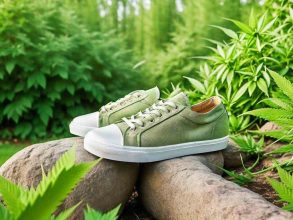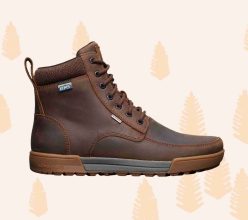- Understanding Minimalist Shoes
- Lems Shoes Overview: Lightweight, Flexible, and Comfortable
- Vivobarefoot Overview: Ultra-Thin, Grounded, and Sustainable
- Lems vs Vivobarefoot: Feature Comparison
- Lems vs Vivobarefoot: Which One Is Right for You?
- Resources for Barefoot and Minimalist Footwear
- FAQs
- Final Thoughts: Which Brand is Better for You?
- Footwear
- Outdoor Gear
Lems or VivoBarefoot are two popular minimalist shoe brands with an approach to footwear that promotes natural foot movement and flexibility.
In this article, we’ll compare these two barefoot shoe brands and look at their features, benefits, and more. From backcountry hikers looking for support on rugged terrain, to casual wearers looking for comfortable shoes to sport around town, there is something here for everyone.
Discover which brand best fits your needs as we explore the difference between Lems Vs Vivobarefoot.
Understanding Minimalist Shoes
Minimalist shoes, also known as barefoot shoes, aim to recreate the sensation of walking or running barefoot. They do this by removing features like arch support and narrow toe box.
In addition, they typically feature a reduced or zero drop heel (meaning there’s little or no height difference between the heel and the forefoot), a wide toe box so you can stretch your toes, and as little sole cushioning as possible to enhance ground feel and proprioception.
Fans of this style believe that minimalist shoes can improve foot health by promoting proper foot biomechanics to reduce the risk of injury from artificial add-ons that don’t resemble natural foot movement.
Lems Shoes Overview: Lightweight, Flexible, and Comfortable
Following a “less is more” philosophy behind their shoe design, Lems lightweight and flexible footwear are designed to be comfortable and user-friendly, even for people who’ve never worn zero-drop shoes before.
Their mission is to remove the unnecessary parts of shoe design that interfere with your foot’s natural movement and toe splay. However, the company does offer moderate support for those that want it, with heel drops that range from 0mm – 4mm.
With models like the Primal Pursuit and the Boulder Boot, the company offers a range of options for those interested in minimalist shoes, including unisex styles, as well as eco-friendly vegan options.
Key Features of Lems Shoes
- Wide toe box: Lems shoes provide ample space for your toes to spread out and move freely, enhancing balance and stability.
- Zero or reduced heel drop: Their designs have anywhere from 0mm – 4mm heel-to-toe elevation, designed to promote a more natural stride and improved posture.
- Flexible sole: Lems shoes feature flexible soles that allow your feet to bend and flex, while still providing cushioned support.
Vivobarefoot Overview: Ultra-Thin, Grounded, and Sustainable
Vivobarefoot specializes in low-profile, slip-on footwear that feature ultra-thin soles to allow wearer to feel almost barefoot. These shoes have a vibrant fanbase, however, may not be suitable for people who aren’t used to having zero arch or ankle support.
All Vivobarefoot shoes have 0mm heel drop, without any supports. Popular models include the Tracker, Galahad and Asher Clark – and most of the company’s product line is designed to be versatile and appropriate for wearing almost anywhere, from the office to the trail.
Key Features of Vivobarefoot Shoes
- Ultra-thin sole: Vivobarefoot shoes have some of the thinnest soles in the market, providing maximum ground feel and proprioception.
- Zero-drop heel: All of their shoes have 0mm heel-to-toe elevation, with zero arch support or sole cushion.
- Puncture-resistant sole: Despite their thinness, Vivobarefoot soles are puncture-resistant, offering protection from sharp objects on the ground.
Lems vs Vivobarefoot: Feature Comparison
Comfort
Lems Shoes offer more cushion and arch support, so their shoes may feel more comfortable, especially to barefoot-shoe newbies. Their approach is to allow the foot to naturally build strength with removing 100% of supports found in traditional shoes.
On the other hand, Vivobarefoot Shoes are more lightweight and have very thin soles so that the user feels the ground as much as possible. Barefoot enthusiasts will appreciate this design that remains true to the minimalist ethos, however, the feeling may not be as comfortable for people who’ve never worn this type of shoe before.
Materials and Construction
Both brands use lightweight materials to create a barefoot-like experience, albeit with very different approaches.
Lems employs a blend of microfiber and air mesh shoe uppers to create breathability and flexibility. Their shoes are designed to feel light on your feet and not weigh you down. However, Lems soles are thicker than Vivobarefoot, with Ultra-Flex rubber soles to provide cushioning and protection.
Whereas Vivobarefoot, on the other hand, truly emphasizes the importance of feeling the earth beneath your feet, and their products have a much more “barefoot” sensation.
The construction is geared around ultra thin, puncture-resistant soles, with materials like recycled PET and leather for the shoe upper. They use a variety of proprietary sole technologies, including SynFlex®, AquaShield®, Sensori‐Flex™ and Wild Hide®leathers.
Style and Aesthetic
Both shoe brands offer a wide range of styles suited for different activities and styles.
While Lems shoes are famous for the minimalistic design of their Boulder Boot and the clean lines of the Lems Primal 2, they are also known for retro styles of the Trailhead V2 and Outlander Boot.
Vivobarefoot shoes have bolder, more unique designs with brighter colors and intricate details such as patterns or stitching .
These differences cater to two very distinct target markets: minimalist shoe fans looking for simplistic styles vs outdoor adventurers who want more rugged looks from their performance-oriented gear.
Functionality
Both brands offer functional designs for various activities, including trail running, hiking, casual wear and even office attire. For example, Lems carries the Trailhead V2 trail running shoes, the 9tofive formal dress shoes for office wear and the Boulder Boot for hiking, while Vivobarefoot’s has the Primus Trail and Tracker for climbing and hiking across challenging terrains.
Price
Lems, generally speaking, is more budget-friendly, with prices ranging from $100 to $150 for most of their shoes. Vivobarefoot, by contrast, commands a higher price point, with products typically ranging from $140 to $200.
Customer Reviews and Ratings
Lems Shoes have earned overwhelmingly positive reviews from customers, who praise the comfortable fit and foot-friendly design. Fans also appreciate that the shoes are designed for all-day wear, while still allowing feet to move naturally.
As a proud owner of a 2 year old pair of Lems Trailhead V2, I can confirm that they are great for everyday wear, whether you’re walking, hiking or running.
Vivobarefoot shoes, on the other hand, can be a bit more polarizing in terms of customer satisfaction. While some people love them for their ultra thin soles and lightweight design, others find them difficult to break in or uncomfortable due to their wide toe box.
Brand Reputation
Both are well-known brands in the minimalist category. While Lems has seen more success in Europe and North America, Vivobarefoot has gained more popularity globally with their expansive distribution channels across Europe, Asia, The Middle East and Africa.
Clinical Studies
Clinical studies within the minimalist and barefoot scientific community have been relatively few, in comparison to other sports-health related research. The body of science is growing and what is known at this point is fairly polarizing and still largely inconclusive.
For example, some research in the field suggests that shoes with a zero heel drop and wide toe box can have potential benefits, including better foot flexibility and function, and a reduction of injuries and sprains (Lieberman et al., 2010; Robbins & Gouw, 1991). Another study by (Hollander et al, 2017) found that minimalist footwear may help improve running form and efficiency.
Furthermore, Vivobarefoot has been the focus of several clinical studies, including an investigation by the University of Liverpool in 2016 which proposed that wearing their shoes may result in increased foot strength and better arch function.
On the flip side of this positive research, there have also been negative reports from studies that cite a higher occurrence of injuries like metatarsal stress fractures, especially among runners who are new to minimalist footwear (Goss & Gross, 2012).
Lems vs Vivobarefoot: Which One Is Right for You?
When comparing Lems and Vivobarefoot, consider the following factors:
- Ground feel: If maximum ground feel is your priority, Vivobarefoot’s ultra-thin soles may be the better choice.
- Cushioning: Lems shoes tend to have slightly more cushioning, making them a better option for those transitioning from traditional footwear.
- Durability: Both brands are known for durability, but Vivobarefoot’s puncture-resistant soles offer extra protection in rough terrain.
- Sustainability: If you value eco-friendliness, Vivobarefoot ‘s use of sustainable materials might sway your decision.
How to select the right brand for you:
- Try on both brands: The best way to determine which shoes work for you is to try them on and see how they feel on your feet.
- Consider your activities: Think about the types of activities you’ll be doing, such as walking, running, or hiking, and choose the shoes that best support those activities.
- Ease into minimalist shoes: Transitioning to minimalist shoes can take time. Start by wearing them for short periods and gradually increase your usage to allow your feet and muscles to adjust.
Resources for Barefoot and Minimalist Footwear
- Whole Body Barefoot: Transitioning Well to Minimal Footwear” by Katy Bowman
- “Minimalist and Barefoot Shoes – a scientific overview” by Xero Shoes
- “The Risks and Benefits of Running Barefoot or in Minimalist Shoes” published in PMC – NCBI
- “Barefoot Walking and Minimalist Footwear: Is it a Good Idea?” by ACT Podiatry
- Lems Shoe Care Guide
- Vivobarefoot Shoe Care Guide
- American Podiatric Medical Association
- Foot Health Facts
- OrthoInfo
- Reddit’s r/BarefootRunning (https://www.reddit.com/r/BarefootRunning)
- Barefoot Runners Society (https://www.thebarefootrunners.org)
FAQs
Why do people wear minimalist shoes?
People wear minimalist shoes so that their feet can move more naturally, have more ground feel, and also build muscular strength in their feet and legs. This can potentially improve posture and stability, and alleviate pain associated with issues like bunions and plantar fasciitis.
How do minimalist shoes differ from regular shoes?
Minimalist shoes are more lightweight than regular shoes, have minimal or zero heel-to-toe drop, less cushioned soles, and a significantly wider toe box.
What are the disadvantages of Vivobarefoot shoes?
Vivobarefoot shoes have been criticized for durability issues, lack of ventilation and expensive price point.
Customers cite reports that the shoes begin to wear out quickly. Additionally, since the minimalist design of these shoes lacks sufficient ventilation, users may find that their shoes can take on and retain unpleasant odors over time.
Furthermore, laces on Vivobarefoot shoes have been known to break down more quickly than the upper materials, potentially requiring replacement after prolonged use.
In terms of cost, Vivobarefoot shoes are generally more expensive compared to other brands in this space.
Are barefoot shoes really better for your feet?
The benefits and risks of barefoot shoes have not been definitively stated by the medical community. Research in National Institute of Health suggests there could be benefits in the way your body moves when running barefoot, including reducing the impact on the knees, decreasing the amount of energy needed to slow down or stop and increased stride frequency.
On the other hand, there are also potential risks like foot injuries, stress fractures and Achilles tendonitis.
From the running community, advocates of the barefoot shoe movement do believe that barefoot shoes have benefits, including better posture, stronger calve and foot muscles, and improved foot flexibility.
They believe that by allowing your toes to move freely with minimal on-shoe impediments, such as extra cushioning or an elevated heel profile, barefoot shoes encourages full range of motion for better gait patterns while running or walking.
Do podiatrists recommend going barefoot?
Podiatrists generally do not recommend going barefoot, as this exposes a person to various potential risks and health complications. Going completely barefoot may put the foot at risk of contracting fungal infections, developing injuries from stepping on sharp objects or picking up diseases such as toxocariasis through contact with animal waste.
As an alternative to going barefoot completely, some podiatrists recommend wearing minimalist footwear that can help reduce these risks while still giving people access to the benefits of being close to the ground e.g increased flexibility and natural movement.
Who should not wear zero drop shoes?
Since there is no raise in the heel area, zero drop shoes can put additional strain on certain areas of the foot such as the Achilles tendon and calf muscles.
For those with an existing injury related to these issues, zero drop shoes could make matters worse and cause further discomfort. It is also not recommended for people who suffer from plantar fasciitis as this flat design does not provide enough support for their feet.
Additionally, individuals with high arches may benefit from extra cushioning which zero-drop shoes lack.
Lastly, elderly individuals may find their balance compromised or even weakened when wearing minimalistic footwear without adequate arch support.
Final Thoughts: Which Brand is Better for You?
Both Lems and Vivobarefoot offer high-quality minimalist shoes designed to promote natural foot movement and improve foot health. While they share some similarities, such as wide toe boxes and flexible soles, there are differences in sole thickness, cushioning, and materials that set them apart.
In short, figuring out which brand is better depends on your personal needs and foot health. Both brands prioritize allowing feet to move naturally, with different materials and designs to achieve this goal.
If you’re new to barefoot and minimalist shoes, or have a particular foot issue, Lems may be the better brand because you’ll have more comfort and support in their shoes.
If you’ve been wearing barefoot shoes for years and feel right at home with the thinnest possible sole, Vivobarefoot may be the right choice for your needs.
Ultimately, both have a loyal customer base and hundreds of positive reviews to support the quality and craftsmanship of their products.
Additional Resources:
- Lems Shoes. Shoe care Guide.
https://www.lemsshoes.com/pages/shoe-care - Vivobarefoot. Shoe care guide.
https://www.vivobarefoot.com/us/customer-care/shoe-care-guide - American Podiatric Medical Association
- Foot Health Facts
- OrthoInfo
- Reddit’s r/BarefootRunning (https://www.reddit.com/r/BarefootRunning)
- Barefoot Runners Society (https://www.thebarefootrunners.org)
- The Ginger Runner (https://www.youtube.com/user/TheGingerRunner)
The Run Experience (https://www.youtube.com/user/TREtherunexperience) - GearJunkie. (n.d.). Vivobarefoot shoes review. Retrieved from https://gearjunkie.com/vivobarefoot-shoes-review
Fair Trade Finder makes product and service recommendations, based on thorough research and comparison analysis. Read more.






